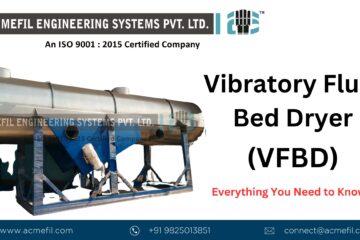When it comes to drying technology, vibratory fluid bed dryers (VFBDs) stand out for their efficiency and versatility. They are widely used across industries such as pharmaceuticals, food processing, chemicals, and more, where precise and consistent drying is critical. This blog delves into the working principle of vibratory fluid bed dryers, explaining their functionality, components, advantages, and industrial applications. By the end, you’ll understand why VFBDs are a preferred choice for many manufacturing processes.
What is a Vibratory Fluid Bed Dryer?
A vibratory fluid bed dryer (VFBD) is a specialized piece of equipment used to dry granular, powdery, or particulate materials. Unlike conventional dryers, VFBDs use a combination of vibration and airflow to create a fluidized bed, allowing for efficient heat and mass transfer. This process ensures uniform drying and minimizes energy consumption, making it ideal for sensitive or heat-sensitive materials.
How Does a Vibratory Fluid Bed Dryer Work?
Key Components of VFBD
To understand the working principle, let’s first look at the main components of a vibratory fluid bed dryer:
- Air Distributor: Uniformly distributes hot air through the material bed.
- Vibratory Tray: Supports the material and provides the necessary vibration for fluidization.
- Heat Source: Provides hot air for drying (electric, gas, or steam-based).
- Exhaust System: Removes moisture-laden air.
- Control Panel: Manages temperature, airflow, and vibration settings.
- Perforated Bed Plate: Allows air to pass through while supporting the material.
The Working Principle
The vibratory fluid bed drying process involves several interconnected steps:
- Material Feeding: Raw material is evenly distributed onto the perforated bed plate using a feeder.
- Airflow Introduction: Hot air is introduced from the bottom, passing through the perforated plate. The upward airflow creates a fluidized state, where particles are suspended in air.
- Vibration Mechanism: The vibratory tray oscillates at a specific frequency, ensuring that particles move uniformly across the bed and avoid agglomeration.
- Heat Transfer: As the material fluidizes, the hot air transfers heat to the particles, evaporating moisture from their surface and interior.
- Moisture Removal: Moisture-laden air is carried away through the exhaust system, maintaining a controlled drying environment.
- Discharge: Dried material is discharged at the end of the bed for collection or further processing.
Why Choose Vibratory Fluid Bed Dryers?
Advantages of VFBD
- Uniform Drying: Ensures consistent moisture removal across all particles.
- Energy Efficiency: Reduces energy consumption compared to conventional dryers.
- Gentle Handling: Ideal for delicate or fragile materials due to controlled vibration.
- Versatility: Suitable for a wide range of materials, including powders, granules, and crystals.
- Scalability: Available in various sizes to suit industrial needs, from pilot plants to full-scale production.
Applications of VFBD
VFBDs are used in industries such as:
- Pharmaceuticals: Drying granules and powders.
- Food Processing: Dehydrating food particles, spices, and flavoring agents.
- Chemicals: Drying chemical powders, catalysts, and detergents.
- Mining: Removing moisture from mineral particles.
- Fertilizers: Drying granular fertilizers.
Expert Tips for Optimizing VFBD Performance
- Calibrate Airflow: Ensure proper airflow distribution for effective fluidization.
- Adjust Vibration Frequency: Set vibration frequency to match the material’s characteristics.
- Monitor Temperature: Avoid overheating to prevent material degradation.
- Regular Maintenance: Clean perforated plates and check for wear on vibratory components.
- Test Material Compatibility: Conduct trials to determine the best drying parameters for specific materials.
Common Issues and Troubleshooting in VFBDs
- Agglomeration of Particles:
- Cause: Insufficient vibration or uneven airflow.
- Solution: Increase vibration frequency or check for obstructions in the airflow system.
- Non-Uniform Drying:
- Cause: Poor material distribution or uneven airflow.
- Solution: Use a more efficient feeder and recalibrate the air distributor.
- Material Overheating:
- Cause: Excessive temperature settings.
- Solution: Reduce drying temperature and monitor using a control system.
Why VFBDs are an Industry Favorite
The vibratory fluid bed dryer working principle offers unparalleled efficiency and flexibility, making it a go-to choice for manufacturers. Its ability to handle heat-sensitive materials while ensuring uniform drying sets it apart from other drying technologies. Additionally, VFBDs contribute to operational cost savings by reducing energy consumption and maintenance needs.
Conclusion
Understanding the working principle of vibratory fluid bed dryers highlights their significance in modern industrial processes. From consistent drying to energy efficiency, VFBDs deliver exceptional performance across multiple industries. If you’re looking for reliable drying solutions, consider integrating a VFBD into your operations.
Acmefil Engineering Systems Pvt. Ltd. stands as a trusted leader in manufacturing Vibratory Fluid Bed Dryers (VFBDs) tailored to meet diverse industry needs. With over two decades of expertise, we design high-quality VFBDs that ensure efficient, uniform drying while maximizing energy savings. Our innovative solutions are ideal for applications in pharmaceuticals, food processing, chemicals, and beyond, offering precision, durability, and scalability. Backed by advanced technology and a dedicated team of engineers, Acmefil delivers unmatched reliability and comprehensive after-sales support, making us the first choice for businesses seeking top-tier drying solutions.


